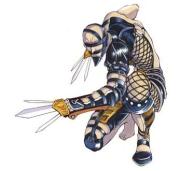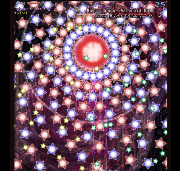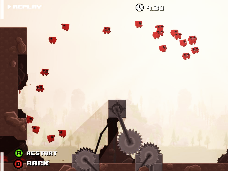Tutorials in games. Do you really need them? I’d like to think not, as I find them disruptive of the game flow at best, and poorly timed insults to my intelligence as a gamer at worst.
Some of the worst offenses commonly found in tutorials are:
- Telling the user what they already know.
- Flooding the user with information that won’t serve them until well in the future.
- Stopping gameplay.
- Not allowing users to revisit them in the future.

Hey listen! You don’t have to torture your players!
But how would you teach the player the rules of your game? Throwing a player into the game without any direction or hints as to how to win can be just as bad as a poorly executed tutorial. Here are 5 of my favorite, general ways to eliminate or greatly reduce the need for a formal tutorial.
1. Give hints based on player metrics and time of the game.
This can be difficult to implement as the developer must take into consideration what metrics to track and when. Reminding the player to use the left thumb stick to move their avatar on the last level is just as absurd as telling the player they can perform a lengthy combo they haven’t unlocked at the beginning of the game.
However, if a player has been running around in an FPS for a few minutes without shooting when they have a loaded weapon and there are enemies in the area would be a situation where it wouldn’t hurt to tell the player how to shoot.
Test playing with non gamers – a method Nintendo was widely known for – is one of the best ways to figure out what isn’t naturally intuitive and what is, allowing developers to pace and find situations that may require the game to give a genuinely helpful hint to the player.
2. Make objectives, not tutorials.

Anything he can do you will do better.
The objectives tell the player a lot about what the game has in store for them. Beat Voldo with every type of throw. What? There’s more than 1 throw type? How do I do them? Suddenly, the mood shifts from being preached at on how to throw to “oh cool, how do I do that?” If stuck, there’s a move list that will display how to accomplish all of the throws.
Every objective is an alert to a new game mechanic. How simple or complex these objectives should be again, depends on audience and game type. In a game for kids, developers should ask the player to perform every basic action as children need more reinforcement than adults.
When developing a game with very deep mechanics, making the mastering individual techniques an objective in a situation conducive to learning it will encourage mastery without feeling like a total drag. Edgemaster Mode in Soul Edge is a stellar example. Continuous play yields substantial, gameplay related rewards in the form of new weapons and the new weapons all have distinct strengths and weaknesses making them conducive to specific play styles. Just don’t force the player to repeat this practice repeatedly, otherwise what was once fun just became a grind.
3. The game as the teacher.

Monkey see…
Monkey do…
I remember old arcade games. Before I inserted a coin, there would be a brief demonstration of what the gameplay was like. Furthermore, the demo would usually show the player rocking out and winning on the hardest difficulty mode possible. I learned a lot about dodging bullet hell patterns in 19XX from the start demo, although emulating those movements for myself was easier said than done.
Nevertheless, my point still stands that the game itself can show players what to do and how to win without spoiling the game. The beauty of 19XX is that it didn’t even need to say a word.

The CPU makes it look easy!
Ridge Racer is a stellar example of how to accomplish this in a racing game. There are several levels of driver ranging from bad drivers will screw up and pose a danger to the player to the ace which knows how to drift through every curve with perfection or regain control if bumped with minimal time lost. These AIs are actually fair which is another reason they’re great examples, but they also serve as examples of how to and how not to drive the course.
Remember those funny looking monkey frogs from Super Metroid? They demonstrated the Wall Jump shortly after the player unlocks that ability. Super Metroid uses relatively cute looking critters to show off new gameplay.
4.Mistakes should be educational.

This is a great metaphor for game development. Really!
Thomas Edison supposedly said “I have not failed. I’ve just found 10,000 ways that won’t work.” Clearly, he was playing Dark Souls, Touhou or Super Meat Boy, as all these games are painfully difficult, but highly rewarding to beat. Of the previous examples listed, Super Meat Boy provides the most ways to ensure that each bloody meat corpse is a brick in the staircase to success.
First of all, Super Meat Boy leaves a trail of red meat juice wherever he goes. This is a great way to measure jumps and further hone timing and positioning of jumps. It’s a gory and more precise form of Hansel and Gretel’s bread crumbs, and something that makes retrying stages far easier. Players can easily track where to go and where not to go. Blood on saw blades and other traps accumulates serving as an increasingly violent reminder of every failure.
Once completing a stage in Super Meat Boy, players are rewarded with seeing all of their attempts replayed together. Some games allow you to see your replays as you play(and even make gameplay out of it like Cursor 10 by Neko Games) which makes subsequent failure even more useful to the player.
5.Sneak the tutorial in other ways.

I never wanted to see this screen again.
Even with flash memory and solid state hard drives, players are still subject to loading or connecting screens. Why not give the player something meaningful to stare at rather than a bland rotating icon? I’ll admit this is a bit of a cop out as far as eliminating tutorials goes, but if there’s no way to avoid a non-interactive screen such as this, at least make it something worth looking at rather than lulling the user to sleep with a hypnotic icon.
If none of the above could possibly apply to your game and you absolutely must have a tutorial, at the very least, allow for players to play them on demand. Players don’t always agree with designers when it comes to what information is relevant when. Allowing players more control over the pace of gameplay will save everyone headaches.





